Preparing Your Trailer Yacht for Sale
Follow these 10 Steps on How to Prepare Your Trailer Yacht for Sale
Many boat owners dread the idea of putting their boat up for sale. If their pride and joy has been sat neglected for some time, perhaps due to Covid or lack of time, the preparations seem like a daunting task. Where to start? We thought these 10 simple steps on the topic would help those of you who have been thinking about putting their yacht up for sale. We will cover the absolute necessities, the nice-to-haves and a few tips to help you underway. Specifically, being trailer sailer specialists, we will also cover some topics which are unique to trailerable yachts. We will use the Cornish Shrimper 19 pictured below as an example throughout this article.
1. A Good Scrub
First impressions count and few buyers have the gift of imagining what a boat could look like underneath a layer of grime. It’s hard to market a dirty boat - many potential buyers never make it past the first few photos, fewer still will give it the thumbs up at a viewing. Viewers get the impression of a badly cared for yacht and suspect that the dirt might be hiding a multitude of sins. A dirty boat will take much longer to sell and will usually fetch many hundreds, often thousands of pounds less in the final sales price.
So, if you want to avoid falling at the first hurdle then scrub the boat top to bottom, inside and out. If you have lack of time, then contact a yacht valet company who will often do a job more efficiently and quickly. If you’re doing it yourself, make sure that the topsides are clean and polished. If your boat is out of the water make sure that all of the underwater growth has been removed with a pressure washer and/or a scraper – we find that a garden hoe works well for this job.
A grubby waterline and faded topsides detract attention
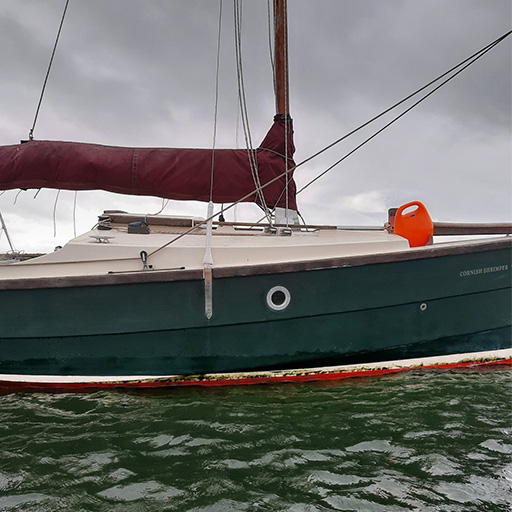
Clean the deck and cockpit, getting into the anti-slip areas with a stiff brush and some bleach solution before giving smooth surfaces a good polish. It’s usually best to avoid household cleaners for this job if you have want to protect polished surfaces - they often contain powerful degreasers.
Remove canvas like sprayhoods and sail covers and get rid of any green algae which has built up – sail launderers will do this but detergent and a brush works too if you’re prepared to give it some elbow grease (Renovo Boat Canvass Cleaner is pretty effective).
Launder Canvas Covers or Give them a clean
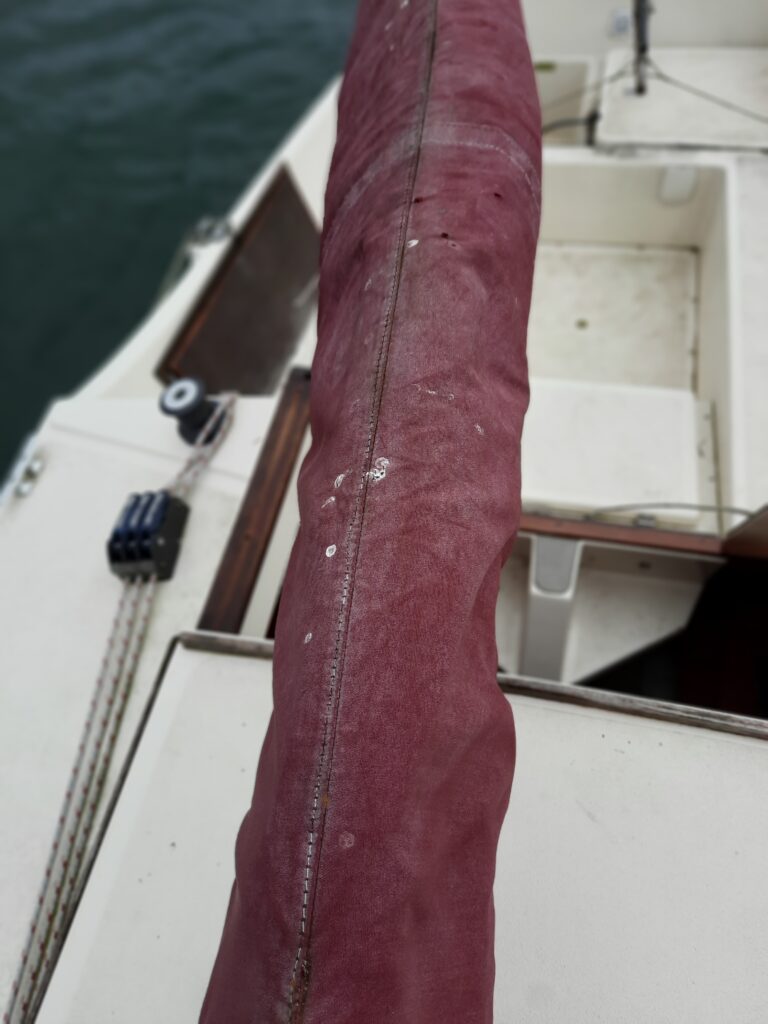
Grubby sails are often best taken to specialist sails launderers for valeting but can be cleaned with a brush and mild detergent.
Remove green running rigging from the spars by pulling mousing lines through and, together with mooring warps and other lines, put them through the wash. Ideally lines should soak in a mild detergent in the bath before a cool wash in the washing machine.
Down below, remove all contents if you can and clean all nooks and crannies, including the insides of lockers, and especially around the galley area if you have one. Remember, viewers will open everything and take a peek. Remove any signs of mildew on headlining and vinyl cushions – a variety of products are available for this but we tend to use a diluted bleach solution (wear a mask!). If you have fabric cushion covers it is often best to remove them and put them through a cool wash in the washing machine.
2. De-Clutter
Its hard for buyers to view your boat if it is full of your personal possessions. So, remove anything which is filling up shelves, lockers and berths unnecessarily. Be ruthless and don’t forget your cockpit lockers! As a minimum anything which is not part of the inventory should not be on the boat. Also remove, sails, covers, spars, lines and fenders, etc from the cabin area for photos and viewings.
3. Avoid Nasty Whiffs
The old adage ‘first impressions count’ is crucially important for selling your yacht. So, many boat owners do an excellent job of presenting their boat in an optimal visual state for photographs and viewings. Yet, many forget about the smell a boat accumulates. Mouldy cabin surfaces, dirty bilges and lockers, damp fabrics and grubby heads can all contribute to a variety of pungent odours which greet the viewer.
Naturally, the best way to avoid these smells accumulating is to keep the boat dry and clean, especially during the winter months. Removing all fabrics like sails, covers and cushions and storing them in a dry place helps. As does a dehumidifier.
However, once a smell permeates the cause needs to be addressed to avoid putting off buyers. So, wash and clean all fabrics and remove all mildew as described before. Get into the bilges, if your boat has them, and pump or sponge out all standing water and oil. Remove the remnants sticking to the bilge surfaces with warm water and detergent – household products like washing up liquid but also general purpose cleaners which add a fragrance help with this task. If you’re lucky enough to have marine heads on your trailer sailer, make sure that all stagnant water is pumped out and replaced with fresh, possibly with the addition of a small amount of suitably fragrant toilet cleaner (choose one which is not corrosive to pumping parts and stopcocks).
Lastly, don’t forget to clean the inside of the cockpit lockers, especially if they are used for fuel containers.
4. Treat Ageing Woodwork

There is little that makes a boat look as tired as peeling varnish and discoloured woodwork. Yet, there is little that makes a boat look better than those natural wood colours.
If your boat has untreated woodwork like teak grab-rails and decking this will benefit from a good clean. Whilst rapid results can be achieved with a pressure washer this quickly shortens the life of the woodwork so we cannot recommend this with a clear conscience. Instead, scrub with a brush and the application of some teak renovator to restore that lovely sanded teak colour – the Wessex Teak Cleaners and Renovators probably offer the best value for money for this job.
Previously varnished woodwork which is now peeling and discolouring needs to be sanded back down to bare wood. If the discolouration proves difficult to shift (and if there is the added risk of rubbing through the laminate) then the application of some oxalic acid may help to revive it but do wear protective clothing and glasses for this treatment. Finally, varnish with a decent brush to give that lovely glossy finish once again. We like to use Epiphanes clear gloss varnish but Tool Station No Nonsense Yacht Varnish does a pretty good job at a much lower price. For a good finish apply 3 coats for cabin areas and as many coats as possible for outdoor woodwork.
Few things on a boat look better than freshly varnished wood
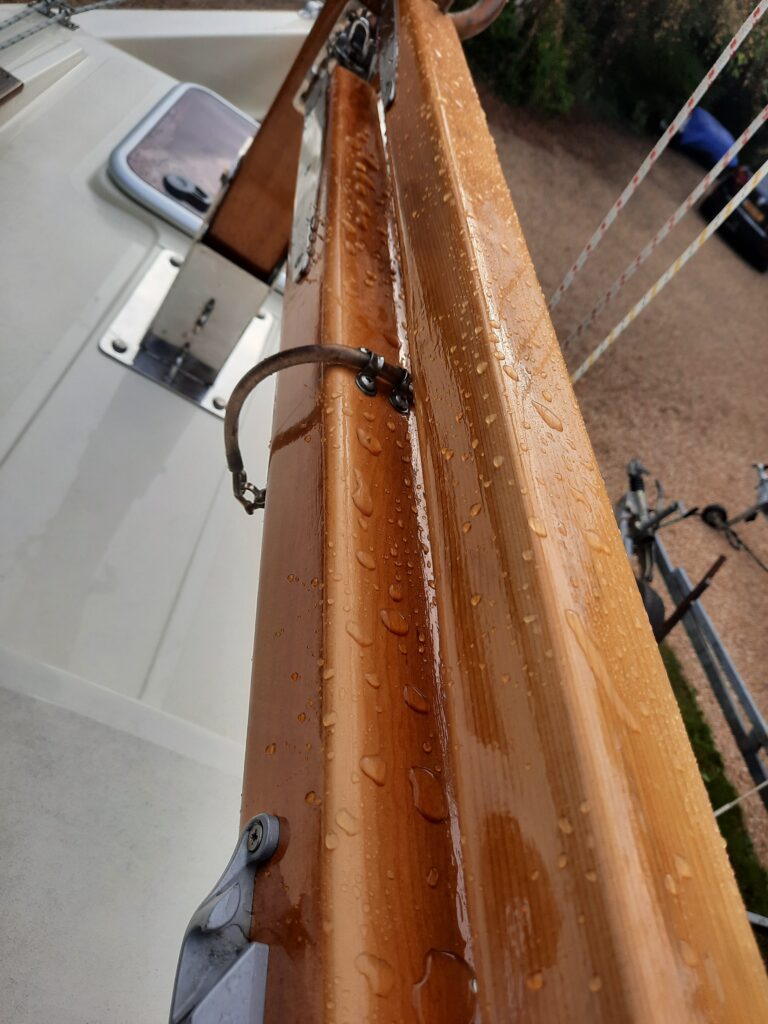
5. Service or Repair Electrics and Mechanical Equipment
Often before they visit your boat, and certainly when they come to view, would-be buyers will ask when specific fixtures were last serviced and whether they are working. They are trying to build a picture of the amount of money and hassle they will go though to make your boat ready for them to use.
So, if a trailer is included in the sale, ensure that its service record is up to date, tyres are fully inflated and not cracking and brakes, bearings and coupling work freely and the electrics work.
Ensure that you have your engine serviced and that its starts. Be prepared to show it working. If the boat is out of the water this may mean running it in a tub (if its an outboard) or connecting a garden hose to avoid the coolant running dry. If this is unpractical a piece of film which shows it running helps to convince buyers that the engine works.
If you have a lifting keel make sure that the mechanism moves freely and replace worn parts like keel pivot pins and lifting cables – on some boats the keel spacers are easy to access and replace when they are on their trailers. Paperwork showing regular keel servicing is always reassuring for viewers. Similarly, do check that the rudder is moving freely and the lifting mechanism works as would-be buyers almost certainly will test this.
Ensure that your battery is charged and that you have tested your electrical items. Repair or replace broken parts or list them as not working to avoid problems later on. Broken transducers or displays of navigational instruments are the cause of many disputes – it’s often not worth repairing or replacing these components so it’s best to remove them or label them as not working in the inventory.
6. Present Your Yacht for Good first impressions
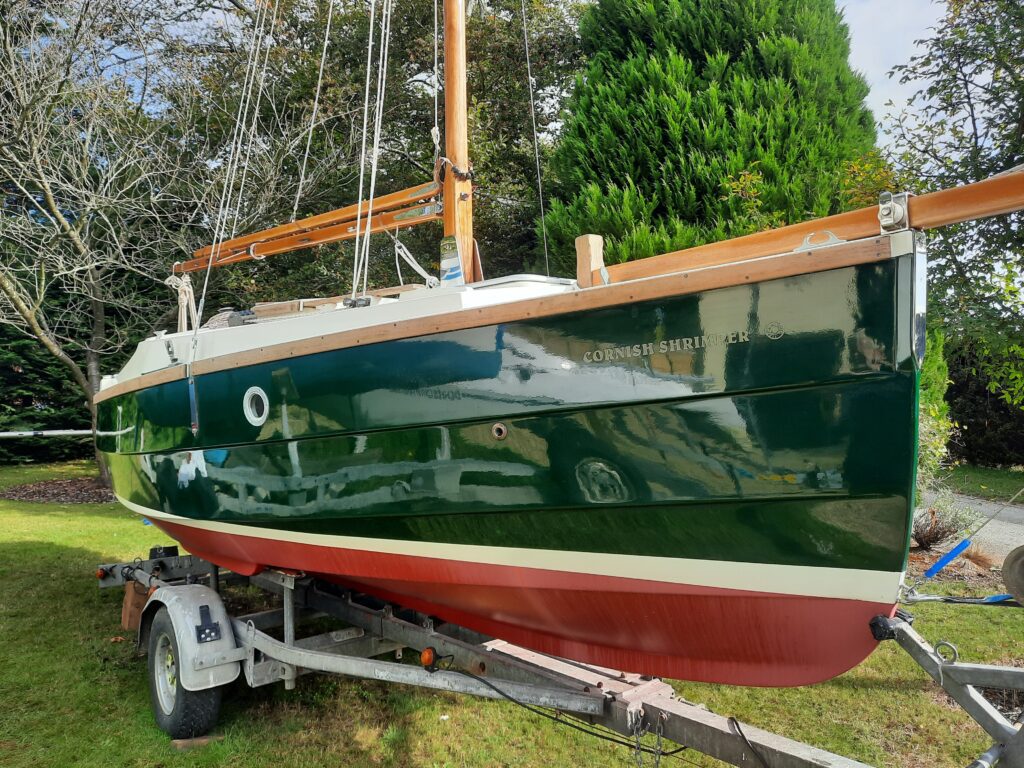
When it comes to presenting your yacht to the buyers there are typically two scenarios, either it will be on its trailer or in the water.
Presenting the boat in the water shows it in its best setting, how it’s meant to be seen. It provides opportunity for the best photos and looks less ominous to the uninitiated viewer.
Yet, showing a trailerable boat on a trailer is helpful as it provides that ‘ready to tow away’ benefit. Added to this it provides buyers with reassurance that they can check the hull under the water line. There are a few things to get right in this scenario though as viewers are seeing the boat at an unnatural angle – boats often look unappealing from underneath. So clean the waterline, not forgetting that brown tide mark which often blights white gelcoat (we use Starbright Instant Hull Cleaner). The boat should be clean under the waterline too - a couple of layers of antifoul help to do wonders to present the boat in the most positive way whilst indicating that its ready to be dropped into the water.
An un-stepped mast placed across the coach roof of a trailer sailer shows the boat in a poor light and makes it difficult to get around for would-be buyers. So, if your mast is down, ideally raise it or, alternatively, place it on trestles by the side of your yacht instead. Getting the boom and spinnaker pole out of the cabin helps to de-clutter the inside of the boat too.
A clutter free cabin invites the viewer in
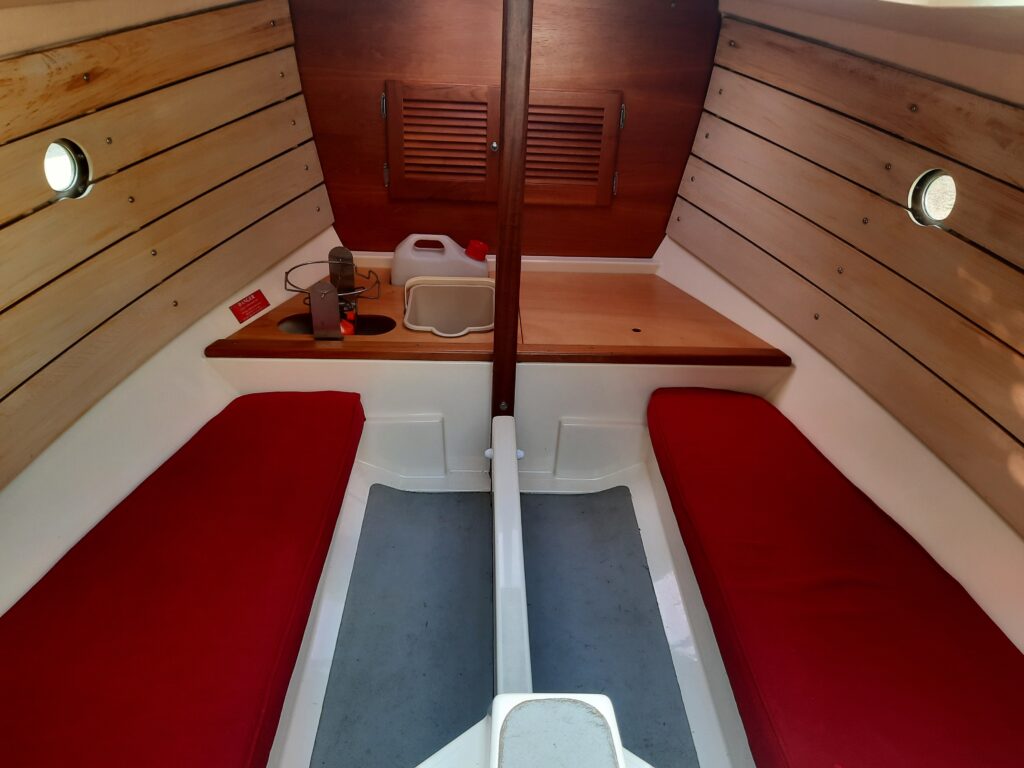
7. Photographing your Yacht
If you're using a local broker they will often come and take good professional pictures of your boat. If you're advertising privately or on behalf of a remote broker then don't be overwhelmed by it. You won't need special skills or equipment - most modern smart phones are perfectly adequate for taking good boat pictures.
Yet, its shocking to see how some yachts are presented. As a result they will obtain fewer viewings and take longer to sell. So, here are a few pointers.
Take a look through the camera to see what will be in view for each shot. Remove any remaining bedding, clutter, etc out of shot, coil lines and neatly arrange items like fenders to provide as clean an image as possible.
Take as many photos as you can from different angles and positions. Take a few from distance if you can and include close ups where possible, focussing in on the features that look best presented.
Take individual pictures of specific items in the inventory such as navigation gear, outboard and comfort features – they almost always make more of an impression in a photo than described in words on a list. If your boat is sitting on its trailer there is no harm in including some library shots of the boat on the water but avoid images which are overly personal - a holiday snap of a bare chested bloke on his boat with a beer rarely helps to sell a yacht!
Take a look at this previous listing as an example of a well photographed boat.
8. Collate paperwork
If you're using a good broker they will almost certainly ask for the paperwork associated with your yacht. But whether your using a broker or not prospective buyers will be interested in proof of provenance - Bills of Sale, ideally since the boat was built, but certainly for that last 5 years. They will also wish to know that VAT has been paid through a copy of the original VAT invoice from the dealer or manufacturer. They will want to know if there is any outstanding finance on the boat and ask for declarations from you or previous owners. They may well ask for the Builders Certificate and a Declaration of Conformity to the Recreational Craft Directive. If you have these documents it is best to collate them straight away and not to wait until the first viewer comes knocking on your door. If, as is often the case with older boats, you have very few documents then there may be ways to get hold of copies. Previous brokers and owners often hold on to copy paperwork following a sale. Manufacturers sometimes have records going back decades - Cornish Crabbers for example have supplied us with previous sales invoices going into the early 90s! But start the paper hunt early. It can take many weeks for documents to come out of the woodwork.
9. Prepare An Inventory
One key bit of paperwork which will be included in a sale and purchase agreement is the inventory of all the items which will be sold with the boat. Your inventory will also form part of your boat listing. Make a list of all the items which you're prepared to include, ideally with the dates when they were first added. It's often best to do this when you're on the boat and checking your lockers and other places where the boat's gear is stored. If there is an item which is not included in the advertised boat price but could be offered as an extra option then make this explicit on the inventory.
10. Finally, Lets be Honest with Each Other
All boat owners would love to see a quick sale for the best possible price. So, it would be tempting for owners to be silent about the boat’s known faults. Buyer beware – you may say - this is what surveyors are there for. Indeed, sellers should be open to a 'sale subject to survey’ – a qualified surveyor is best equipped to point out potential safety risks to the buyer. Yet, trailerable yacht transactions often create some unique circumstances - buyers often don't understand the need for a surveyor and few sellers will suggest one. Remember, for many trailer sailer buyers this will be their very first yacht - at Boats on Wheels around two thirds of our clients are new to yacht ownership. So, you should ask yourself; could you live with yourself if an inexperienced buyer or his crew were injured or even killed as a result of something you’ve omitted to mention? For those who would rather avoid this on their conscience there are a few examples of things to mention regarding safety.
If your yacht has them, out of date fire extinguishers and flares should be removed or the expiry dates should be highlighted in the inventory. If there is a gas installation on board or auto-inflate life jackets are included, make sure to mention when they were last inspected and serviced. If the bilge pumps haven’t been tested lately, test them or state in the inventory that they are untested.
If you have standing rigging which is more than 10 years old or of unknown age this can be a specific risk on trailerable boats. We all know that shrouds and stays get kinked in the mast stepping and un-stepping process. We carry out this process more frequently so the risk of failure of standing rigging is typically bigger than for non-trailer sailers. Regular inspection and replacement of damaged parts is helpful, and buyers should be made aware of the age of the rig and the recency of the last inspection.
Lastly, one of the biggest safety risks of a trailer sailer is the road trailer. We always recommend regular trailer servicing, particularly if the trailer has been regularly salt water immersed and prior to any longer journey. If this hasn’t been done prior to a sale we would recommend that the buyer is made aware of this before he takes a potentially lethal load out on the road.
If you have any questions about selling your trailer sailer or you would like us to help sell your yacht then please don’t hesitate to talk to us at Boats on Wheels.
Good luck with the sale of your boat!

